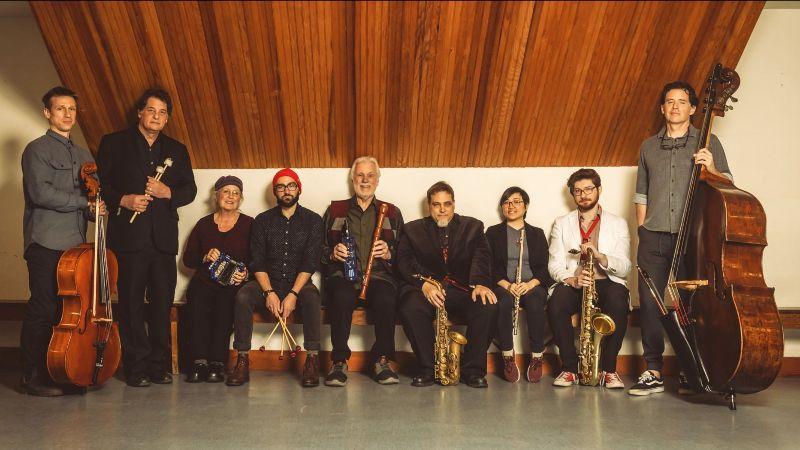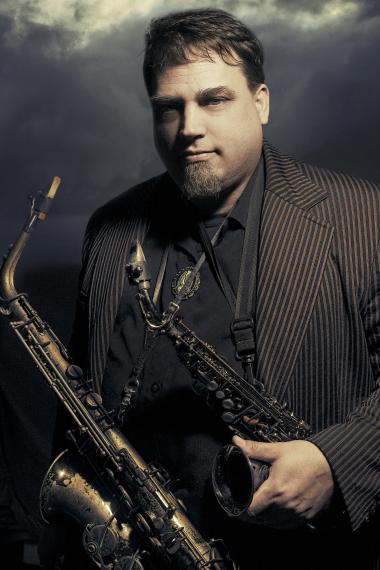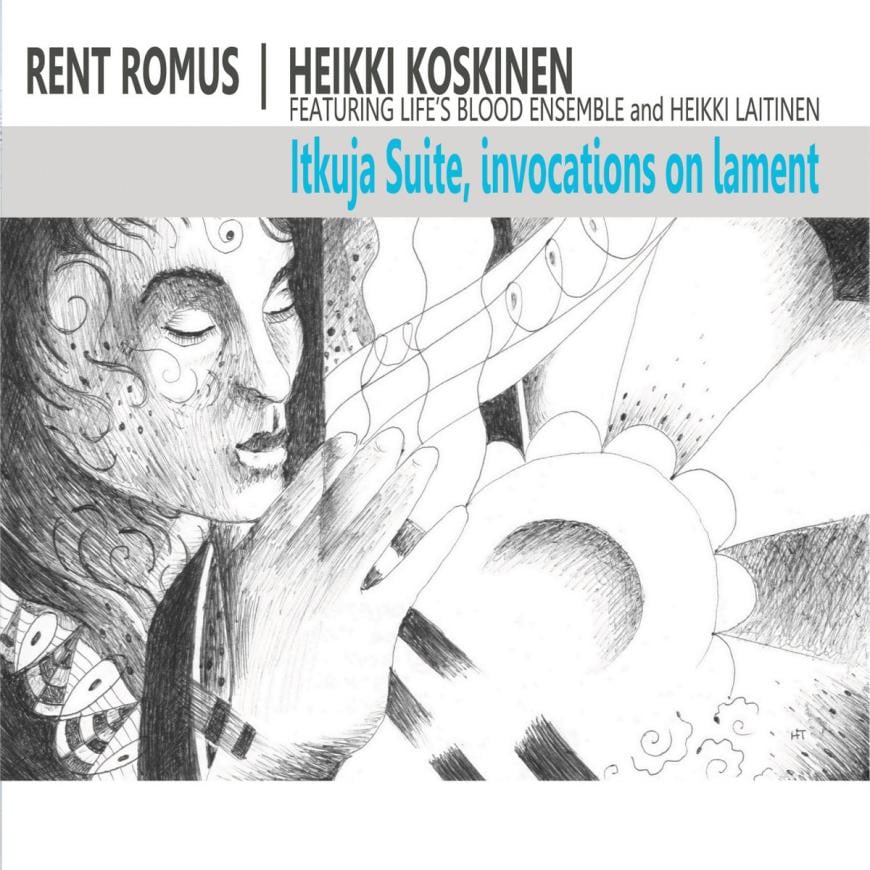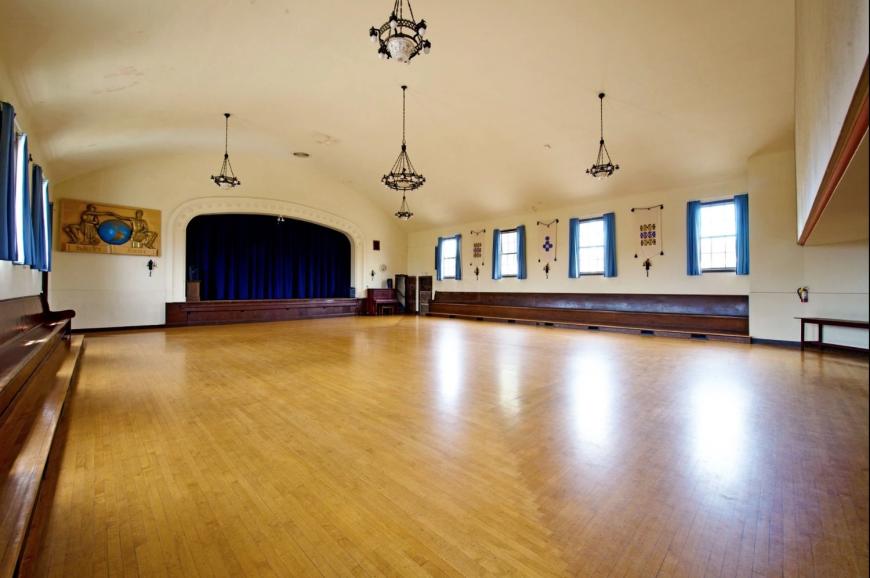
There’s something of a homecoming to the world premiere of the Itkuja Suite at Berkeley’s Finnish Hall on May 27 and 28. And something of a hero’s journey.
Third generation Finnish American saxophonist Rent Romus had spent decades “taking risks” with composing, performing, and recording large ensemble jazz because “I wanted to subvert it to find a new way of dealing with things. I was too out to be in, and too in to be out,” he recounts.
But it wasn’t till he was introduced to Finnish-born trumpeter Heikki Koskinen, now 78 and a fellow resident of the East Bay, that Romus, now 55, was inspired to amalgamate their shared interest in avant garde jazz with an exploration of their shared ethnic cultural roots. Koskinen, whose grandfather was a schoolmate of Jean Sibelius, had been raised studying the Kalevala, a collection of epic poetry, compiled and published in 1835, based in ancient myths of Karelia, the extensive ethnic region straddling present-day Finland and northwestern Russia.

Koskinen shared with his new friend an English language translation of the Kalevala, along with recordings of Finnish free jazz (“The energy, the drive, it punches right through the wall!”, says Romus) and of traditional music. The latter featured the kantele (a plucked chordophone) and the entrancing sounds of itkuja (pronounced ‘eet-koo-ya’), an idiosyncratic form of lament sung throughout Karelia at both funerals and weddings, and to both mourn and celebrate. Romus also got to know the Finnish Hall, where Koskinen performed for holidays and celebrations. The Hall had been established by immigrants in 1932, near what had been dubbed “Finntown,” in West Berkeley.
The Kalevala, considered a foundation of Finnish culture, showcases tales of natural and supernatural challenges, focused on a venerable superhero, Väinämöinen. Romus was fascinated by the role of music in the hero’s adventures on land and sea. “He fights battles, and he can literally sing his opponent into the ground! And he makes use of a kantele, formed from the jawbone of a pike,” a predatory fish.
A couple of years after their meetup in 2013, Koskinen joined Romus’s 10-piece Life’s Blood Ensemble. Following on Sibelius’s example from a century earlier, the pair turned to portions of the Kalevala, in particular tales of the underworld and life after death, for their co-composition Manala, performed around the Bay Area and recorded for Romus’s Edgetone Records label, in 2020. Both men also toured Manala through Koskinen’s native Finland, with the Otherworld Ensemble, comprised of Finnish musicians, and with Heikki Laitinen, a venerated poet, and ethnomusicologist at the Sibelius Academy in Helsinki.
The drama and spirit of the Kalevala informed the tradition of lament singing, as well as Romus’s and Koskinen’s creation over the opening years of the pandemic of their new suite, named for the lament. “The balance between sadness and healing with joy is a central theme of this project,” says Romus. “Lament is a healing tool.”

The composers listened carefully to many hours of field recordings of laments and opened the first track of their Itkuja Suite, released on Edgetone last month, with a 1952 sample from legendary lament singer Domna Huovinen. There’s a delectable musical variety across the 11 sections of the Suite, enlivened by what Romus terms “the life-affirming elements of jazz.” But he also points out the ethnic and cultural influences on “the rhythmic structure, at times referencing the trochaic tetrameter of verse, which has come to be known as the Kalevala meter,” and the prevalence of “a pentatonic element, using the kantele’s tuning of its first five notes, in a minor scale.”
Romus and Koskinen applied the lament form to contemporary and personal issues, including the plight of refugees from the 1940 Winter War between Finland and the Soviet Union, which fractured the Karelian homeland, and Romus’s protracted search for his roots, “spending maybe half of my life just trying to figure out what all this meant.” The Suite also invokes a riddle, the Finnish affection for rye, the role of musicians as interpreters between the living world and the spirit world, and unity across wider Finno-Ugric regions, including the Sámi of northern Scandinavia and the Setomaa people of Estonia.
The size of the Life’s Blood Ensemble and the composers’ approach to their material invite an exciting degree of individual, paired, and group improvisation, a quality also inherent to lament and to the music of Sun Ra and Horace Tapscott, two of Romus’s jazz influences. The Life’s Blood Ensemble is uniquely and attractively arrayed for live performance. Wind players, including Romus and Koskinen, doubling on multiple instruments, share the stage with two basses, cello, drums and percussion, accordion, and vibraphone. In the Suite, Koskinen performs several passages on kantele. At full blast, there’s a panoramic evocation of place, as well as of spirit. Emotions are audible in both instrumental and vocal shoutouts.
The Itkuja Suite has become eagerly anticipated in the Finnish homeland. The composers recently learned that travel expenses for their tour there this summer will be covered by the California-based Finlandia Foundation. Romus and Koskinen will perform, with the Otherworld Ensemble, a dozen concerts of the Suite, one of them at the Sibelius Museum in Koskinen’s hometown of Turku.
Through his recent reclamation of his heritage, Romus has come to realize that “all of the music I’ve ever composed has had some kind of connection to these cultural values. It’s like a body of memory, things that we hadn’t understood and maybe never experienced, but our ancestors did.”

He expects that the Finnish Hall gigs next week will attract loyal fans of visionary jazz, but also many of the Finnish expats Romus has come to know. “They’ve seen my posts and they’ve already been sharing them with their relatives and friends back in Finland.” The government of Finland itself has offered to help sponsor the Berkeley concerts.
For more information, check out Romus’s website at http://romus.net/. You can purchase tickets here, and the Itkuja Suiterecording here. CDs will be on sale at the Finnish Hall, alongside coffee mugs and handkerchiefs bearing Finnish American Helena Tiainen’s evocative design for the album cover.

